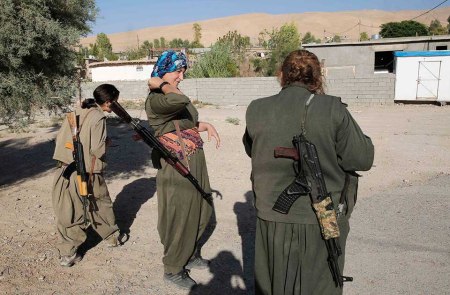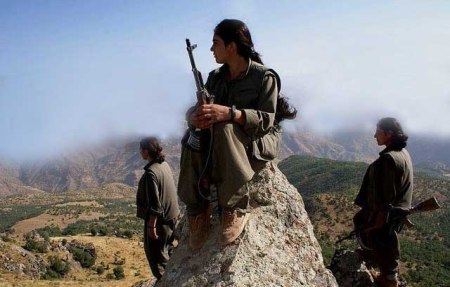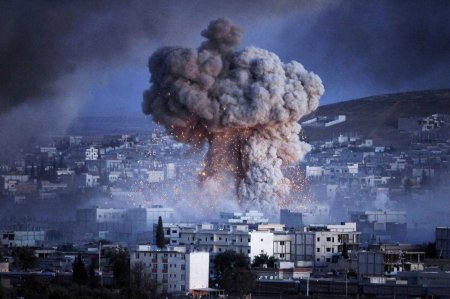Ziad Haydar As-Safir
Media outlets are currently preoccupied with the battle raging in the Syrian town Kobane (Ayn al-Arab). A joke has been recently invented wherein “Syria is located south of Kobane.”
The media interest in this humble town bordering Turkey is fed by political developments and exciting elements such as the female Kurdish fighters with long braids and the “watching” hill on the side of the Turkish border town of Mursitpinar.
Politics, however, remains the main player there; it is the reality of the picture that is hiding behind the colors and the details. “The symbolism of the battle, which temporarily put the spotlight on the international coalition,” as a senior Syrian source told As-Safir, “is one of the most important factors behind the media excitement about the battle.”
The source said, “By historical coincidence,” this battle was probably fed by other factors, including “the proximity to the Turkish-Kurdish border, the Kurdish issue and of course the steadfastness of Kurdish fighters, who, in turn, represent a minority in Syria and the region.”

The battle in Kobane has provoked many. Chief among these is Turkish President Recep Tayyip Erdogan and his prime minister, Ahmed Davutoglu, who issued dozens of statements during the past two weeks criticizing the media’s focus on this particular battle.
These statements were not limited to criticizing the “fuss” raised by the battle, but were accompanied by explicit nervousness in the political performance of the Turks, who set several political and field conditions to enter the international coalition against IS (Islamic State], among them the military targeting of Syrian Army sites and the establishment of a buffer zone within Syria. Turkey finally promised to facilitate the passage of 1,300 fighters from the FSA (Free Syrian Army) to help Kurdish YPG (People’s Protection Units) fighters, following a similar promise to allow 200 members of the peshmerga to pass through Turkey to support their nationalist brothers in the battle, knowing that Erdogan explicitly described the YPG as “part of a terrorist organization.”
The Turkish proposal to allow the movement of troops from the FSA to Ayn al-Arab highlights the Syrian concern more than any other, in an attempt to build a hidden strategy that this media-grasping battle has yet to have.
According to the above mentioned source, the “suspicious Turkish initiative” to send elements of the FSA to the battle makes the Kobane issue go beyond its Kurdish symbolism. Although Kurdish leaders now recognize the existence of fighters from the FSA in Kobane belonging to the “Euphrates volcano” formation, the agreement on the entry of “formations under Turkish influence” is what worries the Kurds and the Syrian government.
Syrians dread the success of the Turkish initiative, which would rapidly pave the way for the transformation of the process to “deter IS from Kobane into an attempt to fill its gap by a well-defined force run by the Turkish intelligence.”
But there are various complications; many factions of the FSA refuse to work under the command of the Turks, while others refuse to work with the Kurds, and others openly abstain from fighting IS. The source believes that this “disparity in alliances” will affect the circumstances after the battle, but no one knows how it will unfold.
According to one of the looming scenarios, a Kurdish victory, which would be in one way or another also a victory for the international coalition, would turn into a base that consolidates Syrian Kurdish politics, in itself based on the achievement of autonomy in Kurdish areas. It was surprising to have the Russian Foreign Ministry welcome this project in a statement, commenting on the recent “unity” agreement between the KNC (Kurdish National Council) and the PYD (Democratic Union Party) in Dahuk.
The statement said that such a move is “a model of unity against IS,” and pointed out at the same time to “Moscow’s interest in the convention on the establishment of a management and of unified forces in Kurdish areas in Syria.” The statement described the agreement as “a model for all Syrian political parties and forces, which guarantees the sovereignty and unity of the country, facing international terrorism and extremism through unity” despite recognizing “that the agreement needs further in-depth study.”

The “self-management” components can be found in the northern areas, where there seems to be a public solidarity on the part of the Syrian authorities, which observers believe hides an “implicit and circumstantial alliance between the two parties.”
The management elements in the three Kurdish provinces of Jazia, Afrin, and Kobane go beyond the existence of YPG and police forces, to the teaching of the Kurdish language in schools, obligatory recruitment, and forming labor unions. It should be noted that state institutions remain active in those areas, knowing that the salary scale across the “self-management” regions depend on the Syrian state.
The Syrian state does not dread “the Democratic Union Party” project for now. The news anchor of the Syrian state TV channel speaks with daily enthusiasm about “the Syrian Kurdish YPG’s defense” of the city of Kobane.
Commenting on earlier official statements about the Syrian government’s support for Kurdish fighters in Kobane, a media source yesterday had to “remind the Kurds that Syria did not stop supplying them with weapons, be it directly or indirectly,” knowing that some Kurdish fighter groups denied that.
Amid this tug of war, there were reports in the last two days that security leaders in the city of Hasakah asked the Kurdish YPG forces to remove their security checkpoints in the city, similarly to what the Syrian army did, as “the city is safe and the real battle is raging outside.” Other information reported IS mobilization near Ras al-Ain in a way that could change the priorities of the battles, as the Syrian Army has already abruptly done.
For now, the bickering will not turn into a problem, as sources indicate. It only aims at reminding the Kurds of their internal alliances before they start “to change their accounts in accordance with the ongoing battle,” especially in light of the Turkish factor and the Kurdish Dahuk agreement, without this implying that a “Kurdish phobia” is being developed on the Syrian side.
In this context, Khurshid Delli, a journalist who specializes in Kurdish affairs, said that the battle of Kobane has highlighted “the Kurdish national character” and “inflamed the Kurds’ feelings in Iraq, Turkey, Iran and outside the region, in a way that can lead to the eruption of the Kurdish nationalism case.”
According to Delli, the battle of Kobane will constitute a milestone in two directions: The first is the “direction or the context of the war against IS in the next stage,” where the Kurds are seen as potential allies on the ground, and the second is “the context of the Kurds’ relationship with the Syrian crisis parties in the form of a challenge to deal with the Kurdish movement and its demands,” without turning a blind eye to the fact that reviving the Kurdish nationalism case is now associated with the problem of the Syrian national situation, be it on the part of the government or the Syrian Opposition Coalition.
Delli believed that the government, by virtue of the absence of a military presence in that region, seemes without real influence, and therefore not concerned with the issue, while the Syrian Opposition Coalition positions were torn between supporting the Turkish stance, especially as it considers the DYP (Democratic Union Party) as an ally of Bashar Al-Assad, and an ambiguity in terms of the failure to take a clear position on the Kobane battle. As a result, most Syrian Kurds felt like the Syrian Opposition Coalition was with the IS attack to control the city.

Media outlets are currently preoccupied with the battle raging in the Syrian town Kobane (Ayn al-Arab). A joke has been recently invented wherein “Syria is located south of Kobane.”
The media interest in this humble town bordering Turkey is fed by political developments and exciting elements such as the female Kurdish fighters with long braids and the “watching” hill on the side of the Turkish border town of Mursitpinar.
Politics, however, remains the main player there; it is the reality of the picture that is hiding behind the colors and the details. “The symbolism of the battle, which temporarily put the spotlight on the international coalition,” as a senior Syrian source told As-Safir, “is one of the most important factors behind the media excitement about the battle.”
The source said, “By historical coincidence,” this battle was probably fed by other factors, including “the proximity to the Turkish-Kurdish border, the Kurdish issue and of course the steadfastness of Kurdish fighters, who, in turn, represent a minority in Syria and the region.”

The battle in Kobane has provoked many. Chief among these is Turkish President Recep Tayyip Erdogan and his prime minister, Ahmed Davutoglu, who issued dozens of statements during the past two weeks criticizing the media’s focus on this particular battle.
These statements were not limited to criticizing the “fuss” raised by the battle, but were accompanied by explicit nervousness in the political performance of the Turks, who set several political and field conditions to enter the international coalition against IS (Islamic State], among them the military targeting of Syrian Army sites and the establishment of a buffer zone within Syria. Turkey finally promised to facilitate the passage of 1,300 fighters from the FSA (Free Syrian Army) to help Kurdish YPG (People’s Protection Units) fighters, following a similar promise to allow 200 members of the peshmerga to pass through Turkey to support their nationalist brothers in the battle, knowing that Erdogan explicitly described the YPG as “part of a terrorist organization.”
The Turkish proposal to allow the movement of troops from the FSA to Ayn al-Arab highlights the Syrian concern more than any other, in an attempt to build a hidden strategy that this media-grasping battle has yet to have.
According to the above mentioned source, the “suspicious Turkish initiative” to send elements of the FSA to the battle makes the Kobane issue go beyond its Kurdish symbolism. Although Kurdish leaders now recognize the existence of fighters from the FSA in Kobane belonging to the “Euphrates volcano” formation, the agreement on the entry of “formations under Turkish influence” is what worries the Kurds and the Syrian government.
Syrians dread the success of the Turkish initiative, which would rapidly pave the way for the transformation of the process to “deter IS from Kobane into an attempt to fill its gap by a well-defined force run by the Turkish intelligence.”
But there are various complications; many factions of the FSA refuse to work under the command of the Turks, while others refuse to work with the Kurds, and others openly abstain from fighting IS. The source believes that this “disparity in alliances” will affect the circumstances after the battle, but no one knows how it will unfold.
According to one of the looming scenarios, a Kurdish victory, which would be in one way or another also a victory for the international coalition, would turn into a base that consolidates Syrian Kurdish politics, in itself based on the achievement of autonomy in Kurdish areas. It was surprising to have the Russian Foreign Ministry welcome this project in a statement, commenting on the recent “unity” agreement between the KNC (Kurdish National Council) and the PYD (Democratic Union Party) in Dahuk.
The statement said that such a move is “a model of unity against IS,” and pointed out at the same time to “Moscow’s interest in the convention on the establishment of a management and of unified forces in Kurdish areas in Syria.” The statement described the agreement as “a model for all Syrian political parties and forces, which guarantees the sovereignty and unity of the country, facing international terrorism and extremism through unity” despite recognizing “that the agreement needs further in-depth study.”

The “self-management” components can be found in the northern areas, where there seems to be a public solidarity on the part of the Syrian authorities, which observers believe hides an “implicit and circumstantial alliance between the two parties.”
The management elements in the three Kurdish provinces of Jazia, Afrin, and Kobane go beyond the existence of YPG and police forces, to the teaching of the Kurdish language in schools, obligatory recruitment, and forming labor unions. It should be noted that state institutions remain active in those areas, knowing that the salary scale across the “self-management” regions depend on the Syrian state.
The Syrian state does not dread “the Democratic Union Party” project for now. The news anchor of the Syrian state TV channel speaks with daily enthusiasm about “the Syrian Kurdish YPG’s defense” of the city of Kobane.
Commenting on earlier official statements about the Syrian government’s support for Kurdish fighters in Kobane, a media source yesterday had to “remind the Kurds that Syria did not stop supplying them with weapons, be it directly or indirectly,” knowing that some Kurdish fighter groups denied that.
Amid this tug of war, there were reports in the last two days that security leaders in the city of Hasakah asked the Kurdish YPG forces to remove their security checkpoints in the city, similarly to what the Syrian army did, as “the city is safe and the real battle is raging outside.” Other information reported IS mobilization near Ras al-Ain in a way that could change the priorities of the battles, as the Syrian Army has already abruptly done.
For now, the bickering will not turn into a problem, as sources indicate. It only aims at reminding the Kurds of their internal alliances before they start “to change their accounts in accordance with the ongoing battle,” especially in light of the Turkish factor and the Kurdish Dahuk agreement, without this implying that a “Kurdish phobia” is being developed on the Syrian side.
In this context, Khurshid Delli, a journalist who specializes in Kurdish affairs, said that the battle of Kobane has highlighted “the Kurdish national character” and “inflamed the Kurds’ feelings in Iraq, Turkey, Iran and outside the region, in a way that can lead to the eruption of the Kurdish nationalism case.”
According to Delli, the battle of Kobane will constitute a milestone in two directions: The first is the “direction or the context of the war against IS in the next stage,” where the Kurds are seen as potential allies on the ground, and the second is “the context of the Kurds’ relationship with the Syrian crisis parties in the form of a challenge to deal with the Kurdish movement and its demands,” without turning a blind eye to the fact that reviving the Kurdish nationalism case is now associated with the problem of the Syrian national situation, be it on the part of the government or the Syrian Opposition Coalition.
Delli believed that the government, by virtue of the absence of a military presence in that region, seemes without real influence, and therefore not concerned with the issue, while the Syrian Opposition Coalition positions were torn between supporting the Turkish stance, especially as it considers the DYP (Democratic Union Party) as an ally of Bashar Al-Assad, and an ambiguity in terms of the failure to take a clear position on the Kobane battle. As a result, most Syrian Kurds felt like the Syrian Opposition Coalition was with the IS attack to control the city.

Keine Kommentare:
Kommentar veröffentlichen